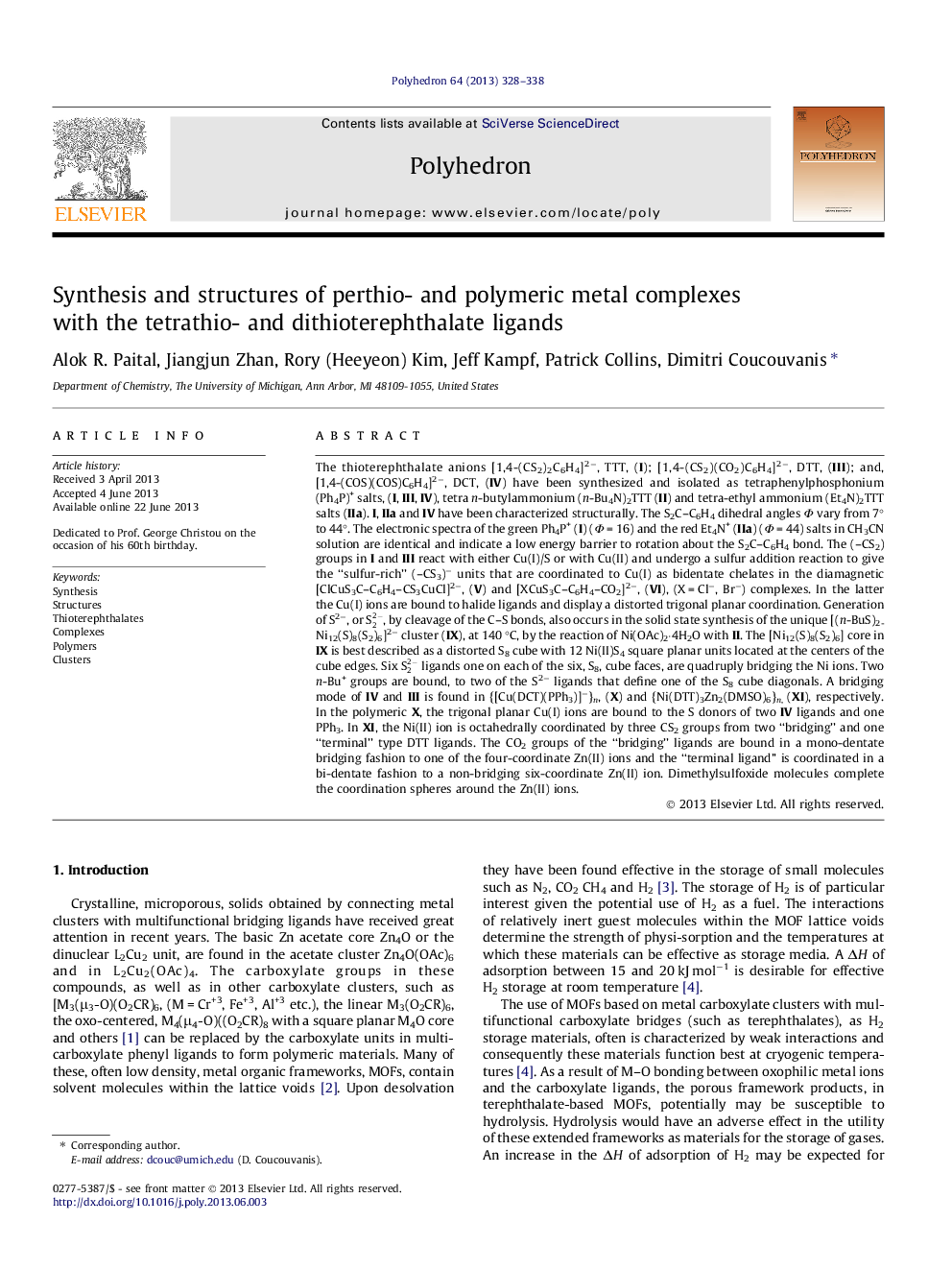| کد مقاله | کد نشریه | سال انتشار | مقاله انگلیسی | نسخه تمام متن |
|---|---|---|---|---|
| 1337057 | 1500275 | 2013 | 11 صفحه PDF | دانلود رایگان |

The thioterephthalate anions [1,4-(CS2)2C6H4]2−, TTT, (I); [1,4-(CS2)(CO2)C6H4]2−, DTT, (III); and, [1,4-(COS)(COS)C6H4]2−, DCT, (IV) have been synthesized and isolated as tetraphenylphosphonium (Ph4P)+ salts, (I, III, IV), tetra n-butylammonium (n-Bu4N)2TTT (II) and tetra-ethyl ammonium (Et4N)2TTT salts (IIa). I, IIa and IV have been characterized structurally. The S2C–C6H4 dihedral angles Φ vary from 7° to 44°. The electronic spectra of the green Ph4P+ (I) (Φ = 16) and the red Et4N+ (IIa) (Φ = 44) salts in CH3CN solution are identical and indicate a low energy barrier to rotation about the S2C–C6H4 bond. The (–CS2) groups in I and III react with either Cu(I)/S or with Cu(II) and undergo a sulfur addition reaction to give the “sulfur-rich” (–CS3)− units that are coordinated to Cu(I) as bidentate chelates in the diamagnetic [ClCuS3C–C6H4–CS3CuCl]2−, (V) and [XCuS3C–C6H4–CO2]2−, (VI), (X = Cl−, Br−) complexes. In the latter the Cu(I) ions are bound to halide ligands and display a distorted trigonal planar coordination. Generation of S2−, or S22-, by cleavage of the C–S bonds, also occurs in the solid state synthesis of the unique [(n-BuS)2Ni12(S)8(S2)6]2− cluster (IX), at 140 °C, by the reaction of Ni(OAc)2·4H2O with II. The [Ni12(S)8(S2)6] core in IX is best described as a distorted S8 cube with 12 Ni(II)S4 square planar units located at the centers of the cube edges. Six S22- ligands one on each of the six, S8, cube faces, are quadruply bridging the Ni ions. Two n-Bu+ groups are bound, to two of the S2− ligands that define one of the S8 cube diagonals. A bridging mode of IV and III is found in {[Cu(DCT)(PPh3)]−}n, (X) and {Ni(DTT)3Zn2(DMSO)6}n, (XI), respectively. In the polymeric X, the trigonal planar Cu(I) ions are bound to the S donors of two IV ligands and one PPh3. In XI, the Ni(II) ion is octahedrally coordinated by three CS2 groups from two “bridging” and one “terminal” type DTT ligands. The CO2 groups of the “bridging” ligands are bound in a mono-dentate bridging fashion to one of the four-coordinate Zn(II) ions and the “terminal ligand” is coordinated in a bi-dentate fashion to a non-bridging six-coordinate Zn(II) ion. Dimethylsulfoxide molecules complete the coordination spheres around the Zn(II) ions.
Dithio- and tetrathioterephthalate ligands, DTT and TTT, yield air stable Cu(I) perthio complexes, such as (PPh4)2[ClCu(SDTT)] and (PPh4)2[ClCu(STTTS)CuCl]. They serve as bridges in heterometallic polymers, such as [(Ni(DTT)3Zn2(DMSO)6)]n and metal ions, such as {[Cu2(DTT)2(PPh3)2]2−}n. The TTT ligands, at higher temperatures, generate S2− and S22- ligands and with Ni(II) afford the [(n-BuS)2Ni12(S)8(S2)6]2− cluster.Figure optionsDownload as PowerPoint slide
Journal: Polyhedron - Volume 64, 12 November 2013, Pages 328–338